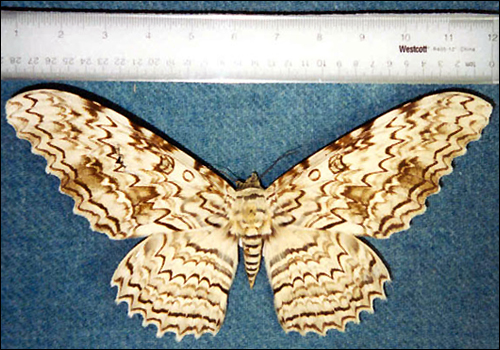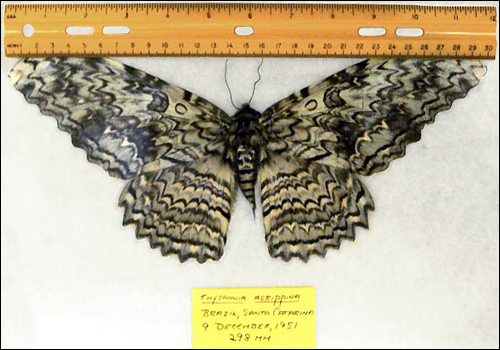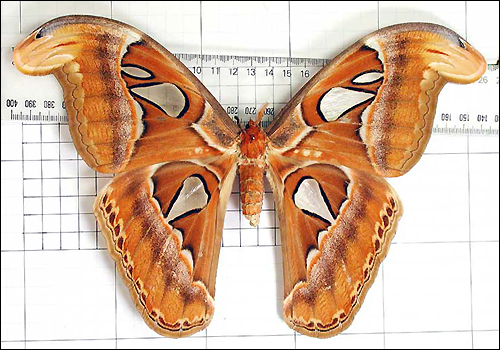Chapter 32: Largest Lepidopteran Wing Span
Hugo Kons, Jr.
Department of Entomology & Nematology
University of Florida, Gainesville, FL 32611-0620
April 17, 1998
Thysania agrippina (Noctuidae: Catocalinae), the white witch moth, has the largest reported wing span of any lepidopteran. This neotropical species is reported to attain wing expanses of up to 280mm. While all books on Lepidoptera and entomology consulted award this status to T. agrippina, no supporting documentation from the primary literature was located. In wing area, some species of Saturniid moths from southern Asia surpass T. agrippina.
Although the vast majority of Lepidoptera species are small and obscure, many species are admired for their size and color patterns by entomologists and non-entomologists alike. Some species of especially spectacular size occur in the moth families Saturniidae (giant silk moths), Sphingidae (sphinx moths), and Noctuidae (owlet moths), and in the butterfly family Papilionidae (swallowtails). This paper investigates which lepidopteran has the maximum wing span.
Methods
To find candidate species, I consulted University of Florida entomologists, general textbooks on entomology, and various books on Lepidoptera. Literature searches of BioAbstracts (1982-1997) and AGRICOLA (1970-1997) were unproductive. In addition, I examined Lemaire’s (1980 & 1988) monographs of new world Saturniidae which include maximum wing expanses for these taxa. Also, I looked up Thysania and agrippina in the index to the Journal of the Lepidopterist’s Society.
Results
While the moth families Saturniidae and Sphingidae may be the most famous for containing many species of spectacular size, the record holder is actually a South American member of the family Noctuidae. All pertinent references consulted agreed that Thysania agrippina (Noctuidae: Catocalinae) has the largest wing span of any lepidopteran in the world. Metcalf and Flint (1951) gave their source as lepidopteran authority W.T.M. Forbes, while other authors neglected to state the source of their information.
The measurements for the T. agrippina wing span vary slightly among different references. Folson (1906) and Metcalf & Flint (1951) reported a wing expanse of 11 inches. Frost (1959) reported T. agrippina spreads 280mm, Richards and Davies (1960) stated its wing span is up to 280mm, and Moucha (1966) gave a slightly smaller measurement of 270mm.
I measured the two specimens in the Lepidoptera research collection at the Florida State Collection of Arthropods housed in the Division of Plant Industry’s Doyle Conner Building, and tip to tip measurements are 260mm and 266mm. However, these specimens were not spread in the standard position for Lepidoptera. The lower margin of the forewing was not raised to a 90° angle with the body, such that the tip to tip measurements are larger than they would be for a normally spread specimen. None of the cited references provided information as to how the wings were spread for the specimens upon which their claims are based.
Discussion
There does not appear to be any controversy in the literature over T. agrippina’s status as the champion for the largest lepidopteran wing span. However, all references I located lack specific information from the primary literature to validate this claim. Consequently, it is likely this claim originates from personal communication with lepidopterists (such as Forbes, noted above) and no supporting measurements have been published in primary literature sources. The only primary literature claim, Wiltshire (1959), stated "and Brazil indeed has the species with the largest wing-span in the world (the Noctuid moth Thysania agrippina)." However, since this reference gave neither a measurement nor a citation it at best can not be regarded as any more reliable than the other references. It is also possible all the reports are copied from the earliest report by Folson (1906), since 270mm and 280mm could be rounded down or up after being converted from 11 inches. A deficiency in all the references is a failure to state the position of the wings for the specimens used to derive the reported measurements. Is the reader to assume the specimens were spread in the typical Lepidoptera format, with the lower forewing margin perpendicular to the body? In addition, the references fail to provide collection data or what collections house the specimens from which their wing span measurements were derived.
Folson (1906) went as far as to claim T. agrippina is the largest living insect. However, in this case it is not clear how "largest" is defined. This claim is not repeated in any of the later references I consulted. The longest and the heaviest insects are subjects of other chapters in this book.
Thysania agrippina apparently holds its wing span record by a decisive margin over other candidate lepidopterans. The apparent second place maximum wing span record holder is the saturniid Attacus ceasar, from the Philippines. This species is reported to have a wing spread of 10 inches by Folson (1906) and 255mm by Frost (1959). A southeast Asian saturniid, Attacus atlas (Linnaeus), is "among the largest moths in the world" (Heppner et. al. 1989). The A. atlas wing span is reported to be nine and one-half inches (241mm) by Folson (1906) and up to 240mm by Frost (1959) and by Richards & Davies (1960). Based on Lemaire’s (1980 & 1988) monographs, the largest wing spans among the new world Saturniid moths are only 190mm, for the species Arsenura sylla hercules and Caio championi.
The maximum wing span of a butterfly is found in the birdwing (Papilionidae), Ornithoptera alexandrae (Parsons 1984). Females of this uncommon species, occupying a restricted range in Papua New Guinea, can attain wing spans exceeding 25cm (Parsons 1984).
T. agrippina apparently does not hold a record for the largest lepidopteran in terms of wing surface area. Moucha (1966) mentions that certain Saturniids from south Asia, including Attacus atlas, have greater wing surface areas than T. agrippina.
Acknowledgements
I thank Dr. T.J. Walker and J. Akers Pence for their review of this manuscript and helpful suggestions and Drs. D.H. Habeck and T.C. Emmel for their suggestions of candidate species. Furthermore, Dr. Habeck and Dr. J.B. Heppner helped by providing entomological and Lepidoptera literature from their personal libraries.
References Cited
- Folson, J.W. 1906. Entomology. P. Blakiston’s Son, Philadelphia.
- Frost, S.W. 1959. Insect life and natural history, 2nd ed. Dover Publications, New York.
- Heppner, J.B., H.Y. Wang, & Y.C. Sen. 1989. Larval morphology of Taiwan Saturniidae (Lepidoptera): Attacus atlas (Linnaeus). J. Taiwan Mus. 42 (1): 89-97.
- Lemaire, C. 1980. Les Attacidae Americains, Arsenurinae. 42, Boulevard Victor Hugo. F. 92200 Nevilly-sur-Seine.
- Lemaire, C. 1988. Les Saturniidae Americains, Ceratocampinae. Museo Nacional de Costa Rica, San Jose.
- Metcalf, G.L. & W.P. Flint. 1951. Destructive and useful insects, 3rd ed. McGraw-Hill, New York.
- Moucha, J. 1966. Beautiful moths. Drury House, London.
- Parsons, M.J. 1984. The biology and conservation of Ornithoptera alexandre, pp. 327-331. In P. Ackery and J. Vane-Wright [eds.], The biology of butterflies. Academic, London.
- Richards, O.W. & R.G. Davies. 1960. A general textbook of entomology, 9th ed. E.P. Dutton, New York.
- Wiltshire, J. 1959. Especially for field collectors. J. Lep. Soc. 13: 79-83.
Addendum
March 30, 2000
Since the original version of this paper was placed on the Web, two collectors have come forward with additional information:
- Peter Brink provided a photograph of a Thysania aggripina specimen from Costa Rica measuring 286mm tip to tip (Figure 1).
- Howard Romack has provided a photo of a Thysania aggripina specimen from Brazil measuring 298mm (Figure 2).
Because the two specimens are spread at different angles, the measurements can not be directly compared. In the Costa Rica specimen the lower margin of the forewing is approximately 6° below a line perpendicular to the body, while in the Brazil specimen the lower forewing margin is approximately 15° below the perpendicular (based on measurements from the right side of the specimen).
After enlarging the photographs of the two specimens, I estimated the distance from the base of the lower margin of the forewing to the tip of the wing to be 146.2mm and 147.7mm for the specimens from Costa Rica and Brazil, respectively. In addition, for the Costa Rica specimen a line from the base of the forewing to the wing tip forms an approximately 65° angle with a line parallel to the midline of the body, thus the distance from the body to the tip on one side is approximately equal to 146.2sin65=132.5mm. Had the Brazil specimen had the wings raised to the equivalent position as the Costa Rica specimen, the length of the same distance would be approximately 147.7sin65=133.9mm.
Consequently, if the Brazil specimen’s wings raised at equivalent angles to the Costa Rica specimen, it would be approximately 1.4mm longer on each side (neglecting a possible slight difference in body widths which would be difficult to estimate from the photos), with a total wing span of approximately 289mm. Howard Romack (personal communication, 2000) raised the point that in nature T. agrippina rests with its forewings at lower angles than on his spread specimen, so the wing span of the moth in its natural resting posture is even larger than the reports given for spread specimens.
Figure 1: Peter Brink's specimen of Thysania aggripina from Costa Rica.
Figure 2: Howard Romack's specimen of Thysania aggripina from Brazil.
Acknowledgment
I gratefully acknowledge Peter Brink and Howard Romack for contacting me with their information on T. agrippina wing span, and for providing me with photographs of their largest specimens.
Editor's Note
March 1, 2005
In a January 13, 2004 e-mail, Peter Lillywhite, of Museum Victoria, Australia, informed me of a large atlas moth (Attacus atlas) collected in 1922 in Java. This specimen had a wing span of 262mm (Figure 3), which makes the atlas moth the lepidopteran species with the second largest documented wing span.
Figure 3: Specimen of Atlas moth (Attacus atlas) with wing span of 262mm, collected in Java in 1922. Photograph courtesy of Peter Lillywhite. [Click on picture to see larger version.]
© Copyright 1998 Hugo Kons, Jr. This chapter may be freely reproduced and distributed for noncommercial purposes. For more information on copyright, see Copyright & Permitted Uses.



